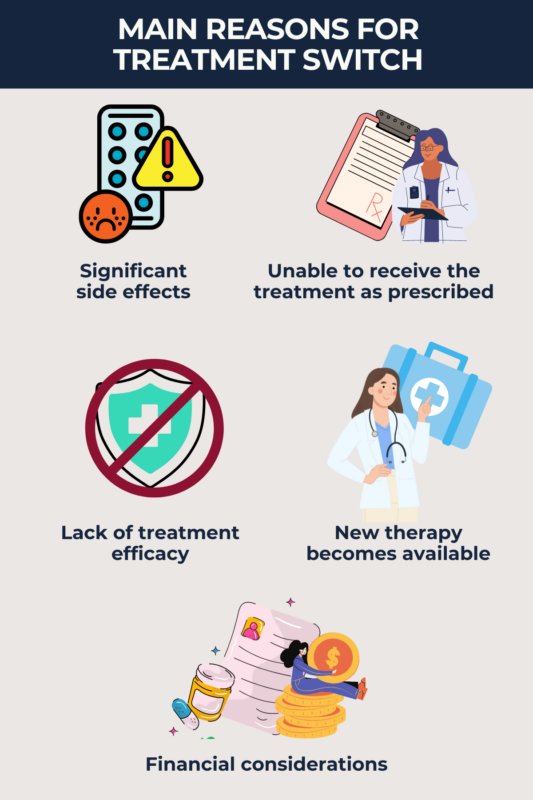
Therapeutic crossroads: Evaluating if it’s time for a treatment switch
Last updated April 22, 2024, by Marisa Wexler, MS

Although there is no cure for Pompe disease, treatments are available that can slow the disease’s progression. Switching treatments may be considered when there are significant side effects, problems with taking a specific medication as directed, or there is substantial disease progression despite treatment.
Pompe disease results from mutations in the gene that provides instructions for the production of the acid alpha-glucosidase (GAA) enzyme. A GAA deficiency causes a toxic buildup of a complex sugar molecule called glycogen in cells, especially muscle cells, and eventually resulting in Pompe symptoms.
Three Pompe disease treatments are currently approved in the U.S. They all are based on enzyme replacement therapy (ERT), a medication that delivers a functional version of the GAA enzyme. In one approved treatment, the enzyme replacement is given alongside a compound that stabilizes the active enzyme.
Treatment switch
There are a few reasons someone with Pompe disease might consider stopping one treatment and switching to another. These include:
- People with Pompe may experience a range of side effects since all available Pompe treatments have different safety profiles. If the side effects from a treatment are not manageable, switching to another therapy to see if it’s easier to tolerate may be an option.
- Like all medications, Pompe disease treatments are most effective when they’re taken regularly and on time. Currently approved enzyme replacement therapies for Pompe are given by intravenous (into-the-vein) infusion, typically every other week, at a medical center, or in some cases, at home. If a person is consistently missing infusions or unable to take their medications as prescribed, it may be worth looking into whether another treatment strategy is a better option.
- Currently, there isn’t any solid data suggesting that any one treatment for Pompe is substantially better than another. That said, every person responds to each therapy differently. Trying another therapy may be considered if one treatment isn’t providing the expected benefits or if there are signs of substantial disease progression despite treatment.
- People who are taking an older therapy may want to look into switching to newer therapies as they become available.
- Financial considerations may prompt a switch in treatments, for example, if a new insurance provider won’t cover a particular therapy.

Whatever the underlying reason for a treatment switch, these decisions should not be made lightly; switching to a new therapy always has inherent risks. Sometimes people would rather stay with a treatment because they already know how it will affect them.
People with Pompe disease or their caregivers should always discuss openly with their healthcare providers any reasons for dissatisfaction with the current therapy and the other available treatment approaches.
Those considering a treatment switch also are encouraged to seek out other forms of support, such as talking to others in the Pompe disease community who have had similar experiences. Pompe Disease News offers additional resources including support through its Facebook page.
Experimental therapeutic strategies
Enzyme replacement therapies have dramatically changed the treatment landscape for Pompe disease, helping people live longer and retain functionality for longer. Still, these medicines are not a cure, and Pompe disease can continue to progress despite ERT treatment.
Beyond ERT, a few other treatment strategies to slow or stop the progression of Pompe disease are currently being investigated. These include:
- gene therapy, which delivers a healthy version of the mutated gene that causes Pompe, helping cells produce a functional GAA enzyme
- substrate reduction therapy to reduce the toxic buildup of glycogen by blocking the production of this sugar molecule
- chaperone therapy, which stabilizes the GAA enzyme so it is better able to remove excessive glycogen
- stimulation of lysosomal exocytosis, which aims to reduce the buildup of glycogen within cells by activating mechanisms that lead to the elimination of the sugar molecule to outside the cell.
Note: Pompe Disease News is strictly a news and information website about the disease. It does not provide medical advice, diagnosis, or treatment. This content is not intended to be a substitute for professional medical advice, diagnosis, or treatment. Always seek the advice of your physician or other qualified health provider with any questions you may have regarding a medical condition. Never disregard professional medical advice or delay in seeking it because of something you have read on this website. The opinions expressed in this column are not those of Pompe Disease News or its parent company, Bionews, and are intended to spark discussion about issues pertaining to Pompe disease.
Related articles




